A new report reveals which clubs had the most arrests and banning orders for the 2021/22 season as football disorder reaches an 8-year high.
Arrests and reported incidents of disorder at football matches in England and Wales last season were at their highest level for eight years with 2,198 football-related arrests made, the highest number since the 2013-14 season, according to Home Office figures.
The campaign saw the return of capacity crowds after a year of Covid restrictions, and last season’s disorder included players being approached after pitch invasions.
The most talked about incidents saw a fan was jailed after running on to a pitch and headbutting Sheffield United captain Billy Sharp at the end of Nottingham Forest’s playoff match against the Blades.
We also saw Manchester City fan run onto the pitch and taunt Aston Villa keeper Robin Olsen on the final day of the season at Etihad Stadium receive a four-year football banning order.
It would seem trouble has rather calmed down for the 2022/23 season, especially with tougher punishments set out for culprits planning on causing trouble or invading the pitch.
Arrests
In the 2021 to 2022 football season, there were 2,198 football-related arrests under Schedule 1 of the Football Spectators Act 1989. Of these, the most common offence types were public disorder (36%) and violent disorder (20%). There had been a downward trend in football-related arrests since the 2010 to 2011 football season; a decrease of more than half (-55%) from 3,089 in the 2010 to 2011 season to 1,381 in the 2018 to 2019 season (pre COVID-19). However, arrests in the latest season were around 59% higher than those in the 2018 to 2019 football season (pre COVID-19), and comparable with levels seen in the 2011 to 2012 to 2013 to 2014 seasons.
Figure 1: Schedule 1 football-related arrests, from 2012 to 2013 football season to 2021 to 2022 football season
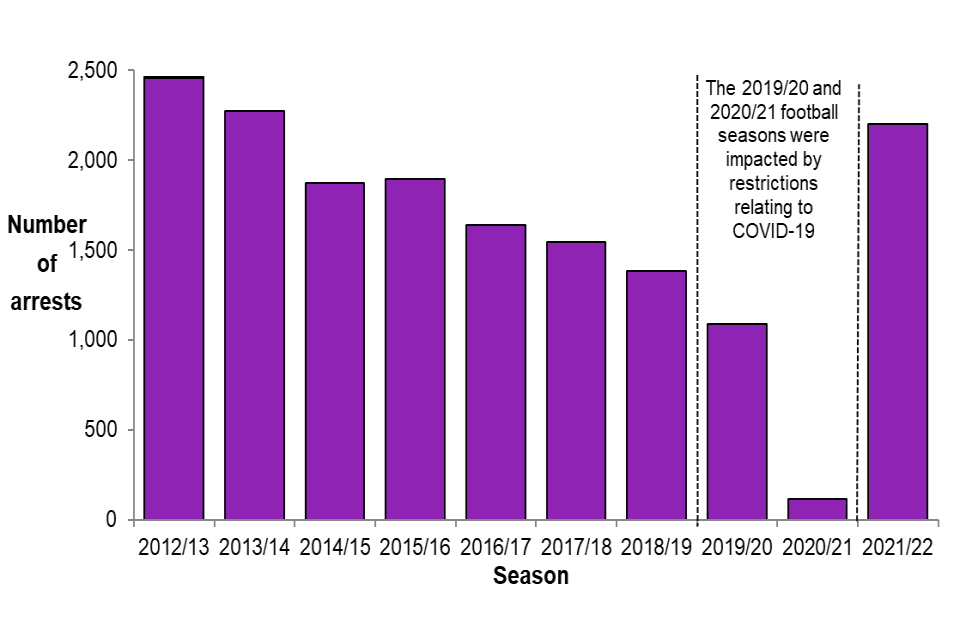
There were an additional 140 Schedule 1 football-related arrests by British Transport Police (BTP), and 314 Other (non-Schedule 1) arrests (excluding BTP) in the 2021 to 2022 football season. In contrast to the arrests shown in Figure 1, BTP and Other arrests both decreased by 10% compared with the 2018 to 2019 season.
Football banning orders
As at 28 July 2022, 1,308 football banning orders were in force. In the 2021 to 2022 football season, 516 new banning orders were issued, which is around 94% of the 2018 to 2019 football season (pre COVID-19) level.
Reported incidents at football matches
Incidents were reported at 1,609 football matches in the 2021 to 2022 football season (53% of matches). The number of matches with reported incidents increased by 60% (+602 matches) compared with 1,007 matches in the 2018 to 2019 season.
The most reported types of incidents were pyrotechnics (729 matches where incidents were reported), throwing missiles (561) and public order or anti-social behaviour incidents involving youth supporters (444).
As at 28 July 2022, there were 1,308 football banning orders in force. This compares with 1,359 as at 1 August 2021 (-4%) and 1,771 as at 1 August 2019 (-26%) (prior to restrictions relating to the pandemic). Figures relating to football banning orders in force will have been affected by changes in the way spectators were able to view and attend matches during the COVID-19 pandemic, and the impacts are likely to remain for the current season due to the duration of a banning order being at least 3 years.
Since the 2022 to 2023 football season commenced on 29 July, due to the Qatar World Cup being played in November and December 2022, the number of all banning orders in force is reported as at 28 July 2022 (rather than 31 July as for previous seasons). Reference dates for new banning orders issued in the 2021 to 2022 football season were 1 August 2021 to 28 July 2022.
Of the 1,308 football banning orders in force as at 28 July 2022, 516 (39%) were new banning orders (issued between 1 August 2021 and 28 July 2022). This is an increase of 308 from the 2020 to 2021 football season (208) and a 6% decrease compared with the number of new banning orders issued in the 2018 to 2019 football season (549).
Figure 2: Number of football banning orders in force in England and Wales, from 2012 to 2013 football season to 2021 to 2022 football season
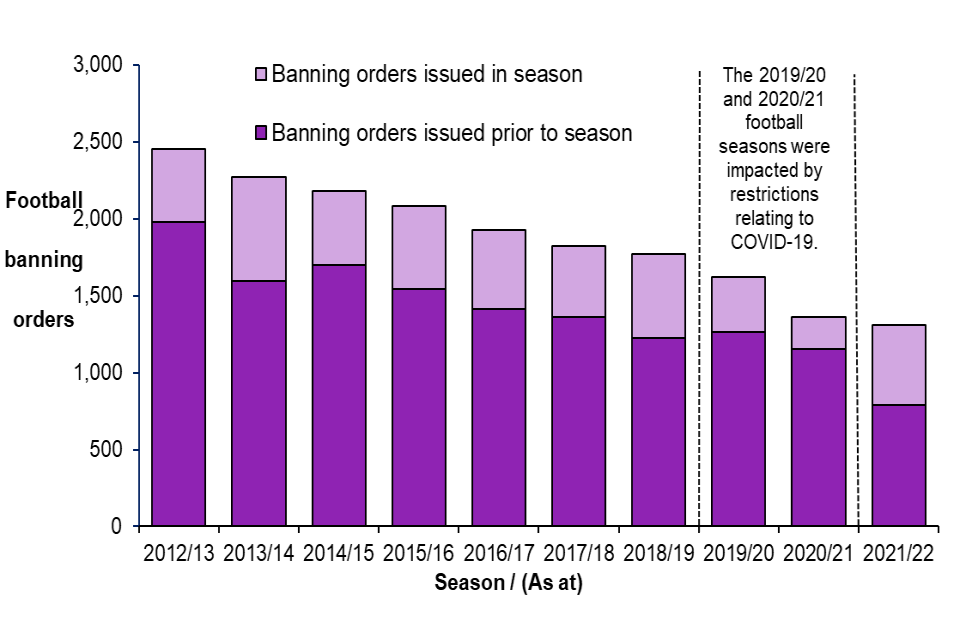
Of the 1,308 banning orders in force as at 28 July 2022, almost all (99.5%; 1,302) were issued to males. Around 70% (910) were issued to those aged between 18 and 34 and less than 3% (36) were issued to those aged under 18.
In the 2021 to 2022 season, Birmingham City supporters had the highest number of football banning orders in force (57), consistent with the previous season. Birmingham City were ranked third in terms of volume of banning orders in the 2018 to 2019 season (57) (pre COVID-19). In the latest season, Millwall supporters had the second highest number of football banning orders in force (52), which is the first time they have ranked in the top five since the 2016 to 2017 season (when they ranked fourth). Bolton Wanderers had the third highest number of banning orders in force in the 2021 to 2022 season (46) compared with ranking at 48 in the 2018 to 2019 season with 12 banning orders. The top five clubs with the highest number of football banning orders in force are shown in Table 1.
Table 1: Clubs with the highest number of football banning orders, 2021 to 2022 season compared with 2018 to 2019 season
| Football club | 2021 to 2022 season | 2021 to 2022 season | 2018 to 2019 season (pre COVID-19) | 2018 to 2019 season (pre COVID-19) |
|---|---|---|---|---|
| Football banning orders | Ranking | Football banning orders | Ranking | |
| Birmingham City | 57 | 1 | 57 | 3 |
| Millwall | 52 | 2 | 43 | 10 |
| Bolton Wanderers | 46 | 3 | 12 | 48 |
| Liverpool | 38 | 4 | 27 | 23 (joint) |
| Everton | 36 | 5 (joint) | 31 | 18 |
| Leicester City | 36 | 5 (joint) | 14 | 45 (joint) |

In the 2021 to 2022 season, Millwall (33), Leicester City (28) and Everton (26) supporters were issued the highest number of new football banning orders.
During the 2021 to 2022 football season, there were 2,198 football-related arrests in connection with regulated international and domestic football matches involving English and Welsh clubs and the national teams (excluding BTP; see the BTP section for football-related arrests by BTP). This is the highest number of arrests made in a season since the 2013 to 2014 season, when 2,273 arrests were made, and is a 59% increase from 1,381 in the 2018 to 2019 football season.
Nearly two-thirds (64%; 1,404) of the 2,198 arrests in the 2021 to 2022 football season occurred inside the football ground, which compares with 59% in the 2018 to 2019 football season (and 37% in the 2020 to 2021 football season).
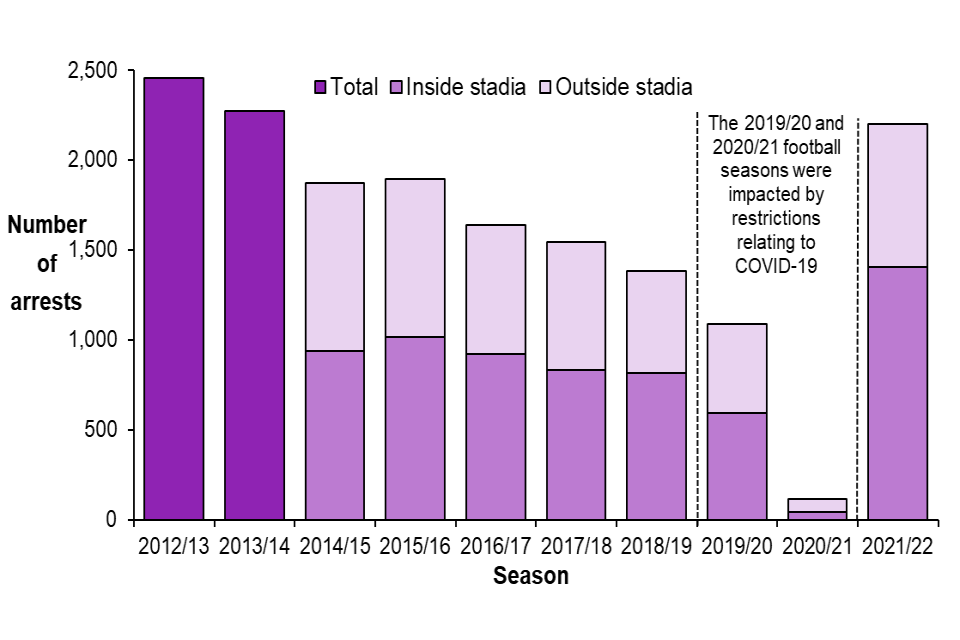
During the 2021 to 2022 football season, there were 38 football-related arrests at England and Wales national team matches (2% of total arrests), of which 3 occurred at the Women’s Euro 2022 matches and 10 occurred outside England and Wales. This compares with 18 arrests at national team matches in the 2018 to 2019 season and 92 arrests in the 2020 to 2021 season (of which 90 occurred at Euro 2020 matches).
There were 121 football-related arrests at European competition matches in the 2021 to 2022 season (i.e. matches where an English or Welsh team (excluding the national teams) played in a European tournament); of which 12 (10%) occurred abroad. This compares with 69 arrests at European competition matches in the 2018 to 2019 season.
There were a further 2 football-related arrests at matches involving international teams playing at the Women’s Euro 2022 held in England (which are not included in the total Schedule 1 arrests due to there being no England or Wales national teams playing).
The most common football-related arrest offence types were public disorder (36%), violent disorder (20%), and pitch incursion (14%), as shown in Figure 4. These were also the most common offence types in the 2018 to 2019 season. Arrests for violent disorder increased by 72% (+186) and arrests for public disorder increased by 50% (+262) compared with the 2018 to 2019 season. Arrests for most offence types showed an increase in the 2021 to 2022 season (compared with pre COVID-19 levels), with just small decreases in ticket touting, possession of an offensive weapon and breach of a banning order offences. In the previous season (2020 to 2021), which was heavily impacted by COVID-19, the most common offence types were violent disorder (36%), public disorder (34%) and alcohol offences and or driving under the influence of drink or drugs (11%).
Compared with the 2013 to 2014 season, which had a similar total number of Schedule 1 arrests as the 2021 to 2022 season (2,273 arrests), there were notable increases in offence types of pitch incursion (+139) and throwing missiles (+112), and decreases in alcohol offences and or driving under the influence of drink or drugs (-359) and ticket touting (-91).
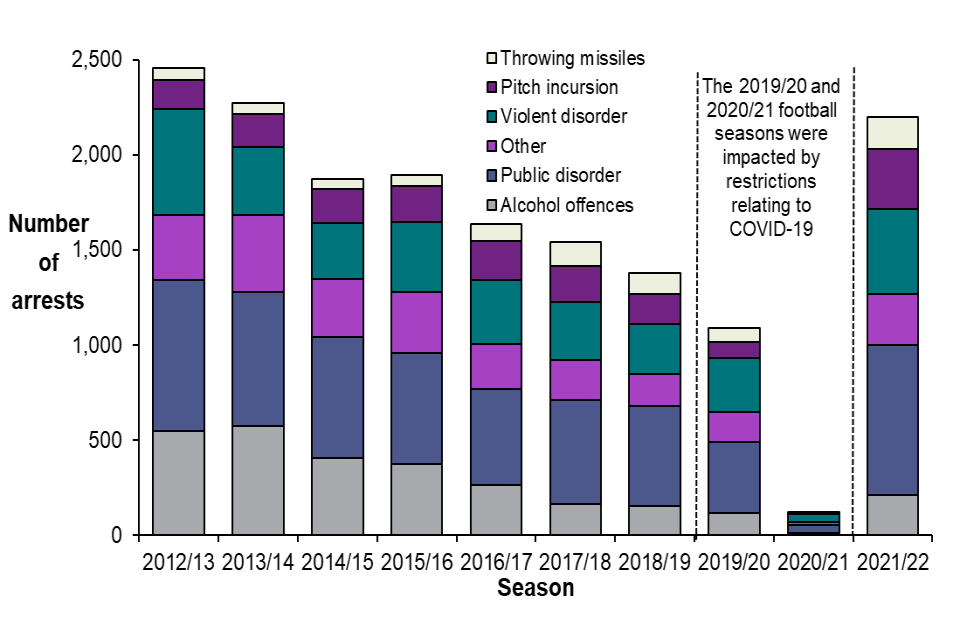
For clubs in the top 5 divisions, just over half (52%; 1,061) of the 2,056 football-related arrests were at home games. Compared with the 2018 to 2019 season (pre COVID-19), there was an increase in arrests for 82 of a total 115 clubs in the top 5 divisions (71% of clubs) for 2021 to 2022 season. The club with the highest number of supporters arrested in the 2021 to 2022 season was West Ham United, with 95 arrests, as shown in Figure 5. West Ham United also had the largest increase in arrests compared with the 2018 to 2019 season (+70).
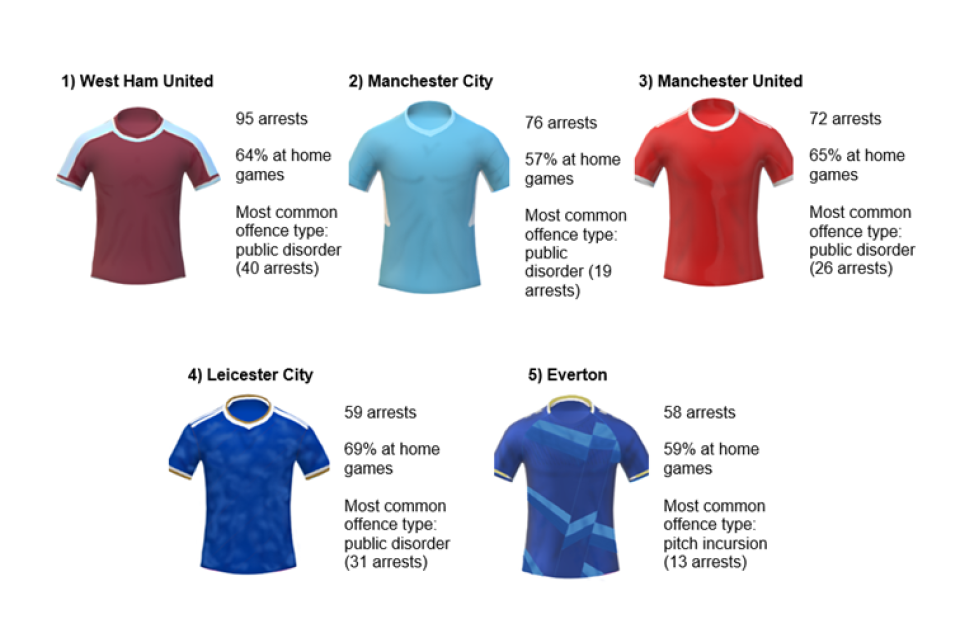

The football-related arrest rate in the 2021 to 2022 football season was 5.2 arrests per 100,000 attendees, the highest rate seen over the period that arrest rates have been published (since the 2014 to 2015 season). Of all competitions with 30 arrests or more, the FA Cup had the highest arrest rate of 8.7 arrests per 100,000 attendees; whilst International competitions had the lowest arrest rate of 3.2 arrests per 100,000 attendees.
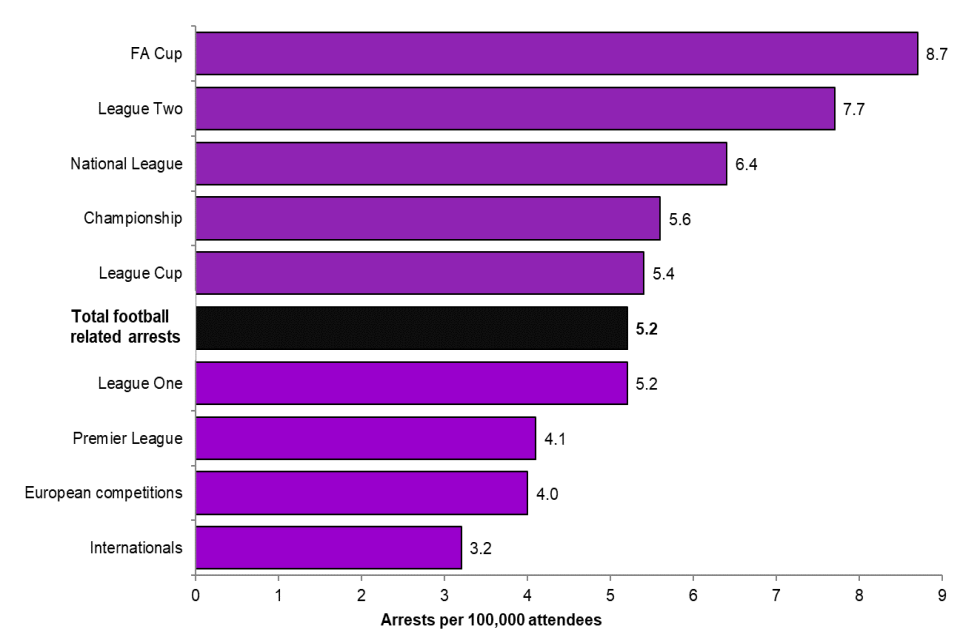
It follows recent comments by England internationals Jordan Henderson and Eric Dier, who both say there is an issue with fan behaviour at football.
Tottenham’s Dier says he feels “too uncomfortable” for his family to attend away matches, while Liverpool captain Henderson says his family’s experiences could “put them off going to future games”.
“[Fan behaviour] has definitely got worse,” Dier said.
“For me it is a serious problem. I had some family and friends at the Chelsea away game with Tottenham and they had problems.
“I wanted to emphasise it was both sets of fans – I am not saying it is Chelsea fans or Tottenham fans, it is football fans in general.”
Henderson added: “My family and friends have had a couple of experiences over the last couple of years, which has really shocked them and probably put them off going to future games.
“When you see scenes like you have in the Euros final, in the Champions League final, then they don’t really want to go and put themselves in that situation again.
“My wife and kids had to try and get in a side door (at Wembley) which they wouldn’t let them in at the beginning. And they were trapped.”
Football Policing Lead chief constable Mark Roberts says disorder is a “problem” that has not gone away from any level of the professional football pyramid.
“Following constructive talks with the Premier League, English Football League and Football Association we are keen to support our partners in delivering their proposals – which include the introduction of stadium bans for people who enter the pitch, as well as those who use pyrotechnics,” said Roberts.
“We are also pleased that the Government is adding Class A drugs offences to the banning order legislation. This will provide police with another option to tackle criminal and anti-social behaviour by those who are under the influence of drugs.”













You must be logged in to post a comment Login